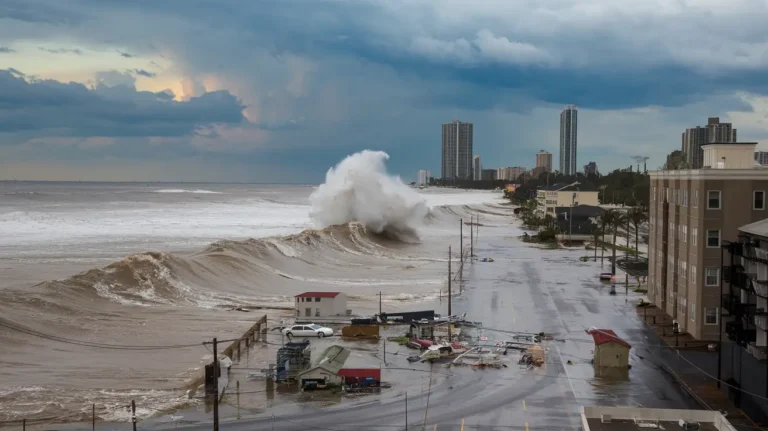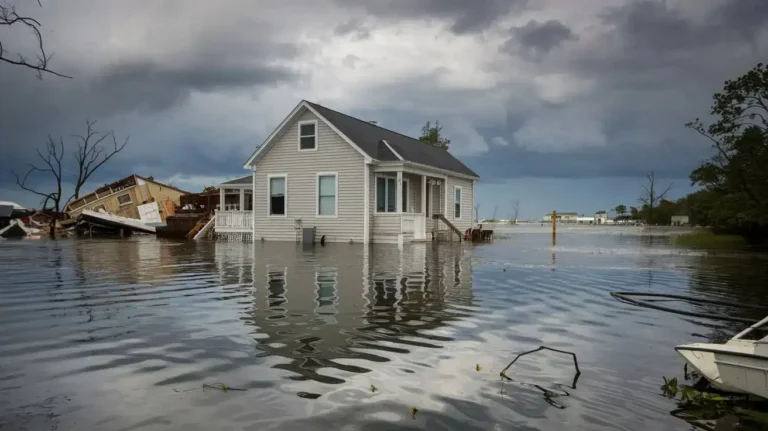When powerful storms like hurricanes or cyclones roar toward coastal areas, they bring more than just wind and rain; they unleash a silent yet devastating force known as a storm surge. But what is a storm surge, and why does it pose such a significant threat? Simply put, it’s a rapid rise in sea level caused by a storm’s intense winds and low pressure, pushing massive amounts of water onto land. This phenomenon can flood communities, destroy homes, and disrupt lives in mere moments.
With climate change fueling more frequent and intense weather events, understanding what a storm surge is has never been more critical. This blog aims to shed light on the science behind storm surges, their dangers, and how they are predicted. By the end, you’ll not only grasp the risks but also learn how to prepare and protect your property from their destructive impact. Let’s dive in!
Table of Contents
What is Storm Surge?

A storm surge is a rapid and dangerous rise in sea level that occurs during powerful storms like hurricanes, cyclones, or typhoons. It happens when strong winds push ocean water toward the shore, combined with the low pressure of the storm “lifting” the water surface. This creates a wall of water that can flood coastal areas, often with devastating consequences. To put it simply, a storm surge is not just a wave, it’s a massive influx of seawater that can overwhelm everything in its path.
The science behind a storm surge is fascinating yet alarming. As a storm approaches land, its winds act like a giant plow, driving ocean water forward. At the same time, the storm’s low pressure causes the sea level to rise temporarily, adding to the surge. When this water reaches the shore, it can extend far inland, depending on the storm’s intensity and the area’s geography.
Historical examples, like the Katrina storm surge in 2005, show just how destructive this phenomenon can be. Katrina’s surge reached up to 28 feet in some areas, flooding 80% of New Orleans. Similarly, Superstorm Sandy in 2012 brought an 8-foot surge that crippled parts of New York and New Jersey. Even smaller storms, like Hermine Storm, have caused significant surge-related damage, proving that no coastal area is immune.
To better understand the concept, imagine a storm surge as a giant, fast-moving tide that doesn’t retreat. It’s not just water it’s a force that carries debris, erodes beaches, and destroys infrastructure. By grasping the storm surge meaning and its potential impact, we can better prepare for these natural disasters and protect our communities.
Why is Storm Surge so Dangerous?
When we ask, “What is storm surge?”, the answer often focuses on its scientific definition. But the real question is: why is it so dangerous? The destructive power of a storm surge lies in its ability to transform calm coastal areas into disaster zones in a matter of hours. The most immediate threat is flooding, which can submerge entire neighborhoods, ruin homes, and trap residents. Unlike regular flooding, storm surges bring saltwater inland, which can damage ecosystems, contaminate freshwater supplies, and leave behind long-term environmental scars.
But the dangers don’t stop there. Storm surges also cause severe erosion of beaches and destruction of critical infrastructure like roads, bridges, and power lines. For example, during Tampa storm surge events, even moderate surges have washed away shorelines and damaged properties, leaving communities vulnerable.
The sheer force of the water can sweep away cars, uproot trees, and collapse buildings. Perhaps the most heartbreaking consequence is the potential for loss of life and displacement of communities. In 2005, Hurricane Katrina’s storm surge was responsible for over 1,500 deaths and displaced more than a million people, showcasing the human toll of these disasters.
What makes storm surges even more terrifying is their unpredictability and speed. A surge can rise rapidly, catching people off guard and leaving little time to evacuate. For instance, the damage from Hurricane Michael in 2018 included a sudden 9-foot surge that overwhelmed parts of Florida’s Panhandle. Real-life stories and statistics like these underscore the importance of understanding and preparing for storm surges. By recognizing their dangers, we can take steps to protect ourselves, our loved ones, and our properties from their devastating impact.
How is Storm Surge Predicted?

Accurate storm surge prediction is essential for saving lives and reducing damage in coastal areas. Meteorologists use advanced weather models, tide gauges, and satellite data to track incoming storms and estimate how much water will be pushed inland. By analyzing wind speeds, atmospheric pressure, and ocean depth, experts can determine how severe a surge might be and which areas are most at risk.
The National Hurricane Center (NHC) plays a crucial role in forecasting storm surges and issuing timely warnings. They rely on real-time data from satellites and ocean buoys to provide storm surge alerts. For example, during Hurricane Ian, the storm surge in Naples reached over six feet, leading to catastrophic flooding. Early predictions allowed many residents to evacuate, preventing further loss of life.
Communities like Milton also rely on storm surge prediction tools to prepare for extreme weather events. Without accurate forecasts, people may underestimate the power of rising waters, leading to devastating consequences. Understanding what is a storm surge and how it is predicted helps residents take action before disaster strikes. Staying informed through weather updates and emergency alerts is the best way to ensure safety when a storm approaches.
How Far Inland Can Storm Surge Go?
When we ask, “What is a storm surge?”, one of the most pressing questions is how far inland it can reach. The answer depends on several factors. First, the topography of the area plays a huge role: flat coastal regions, like those in Florida or Louisiana, are far more vulnerable than hilly or mountainous areas. Second, the intensity and size of the storm matter. A powerful hurricane can push water much farther inland than a weaker storm. Finally, tidal conditions during the event can amplify the surge, especially if it coincides with high tide.
For example, during Hurricane Katrina, the storm surge traveled up to 12 miles inland in some areas, devastating communities far from the coast. Similarly, Hurricane Ian’s surge in 2022 flooded neighborhoods up to 10 miles inland in Southwest Florida. These examples show that storm surges aren’t just a coastal threat they can impact areas many might consider safe.
To visualize this, imagine a map showing how water spreads like a blanket over low-lying areas, reaching farther than most people expect. Understanding what a storm surge is and how far it can go is crucial for preparedness. Whether you live near the coast or miles inland, knowing the risks can help you stay safe when the next big storm hits.
What Does a Five-Foot Storm Surge Mean?

A five-foot storm surge may not sound extreme, but it can cause devastating flooding, especially in low-lying areas. Water this high can submerge roads, damage vehicles, and flood the first floors of homes and businesses. Even sturdy buildings can suffer structural damage, while power outages and water contamination make recovery even harder.
Many people underestimate smaller surges, but what is a storm surge if not an unstoppable force of nature? Just a few feet of water can turn streets into rivers and make evacuation nearly impossible. Homeowners in storm-prone areas should prepare by securing important belongings, sealing entry points, and following evacuation orders to stay safe before disaster strikes.
Trust San Diego Home Remodeling for Water Damage Restoration
Storm surges don’t just flood streets; they leave behind severe water damage that can ruin homes and businesses. From soaked drywall and warped flooring to mold growth and electrical hazards, the aftermath of a storm surge can be overwhelming. Without fast and professional restoration, lingering moisture can weaken a home’s structure and create long-term health risks.
At San Diego Home Remodeling, we specialize in helping homeowners recover quickly with expert Water Damage Restoration San Diego Services. Our team responds fast to remove standing water, dry affected areas, and restore your home to its original condition. Quick action is crucial to prevent further damage, so don’t wait to contact us today for reliable water damage restoration and peace of mind after a storm.
Conclusion
Understanding what is storm surge is essential for anyone living in coastal areas. Storm surges can cause catastrophic flooding, severe property damage, and life-threatening conditions, often reaching miles inland. Predicting them accurately helps communities prepare, but even a five-foot surge can have devastating effects. Taking precautions and knowing when to evacuate can make all the difference in staying safe.
If your home suffers water damage after a storm surge, quick action is critical. San Diego Home Remodeling is here to help with expert restoration services to protect your home and prevent further damage. Stay informed, stay prepared, and don’t hesitate to reach out for professional assistance. If you found this blog helpful, share it with others to spread awareness about the dangers of storm surges and how to stay safe.
FAQs
Can storm surge affect areas that are not near the ocean?
Yes, storm surge can push water miles inland, especially in low-lying areas near rivers, bays, or lakes connected to the ocean. The impact depends on the land elevation and storm strength.
Is storm surge worse at high tide?
Yes, storm surge combined with high tide leads to “storm tide,” making flooding much worse. When storm surge occurs during high tide, water levels rise significantly, causing more destruction.
What should I do if a storm surge is predicted in my area?
Follow evacuation orders immediately, move to higher ground, secure your home, and prepare an emergency kit with essentials like water, food, and important documents. Never underestimate the power of rising water.
